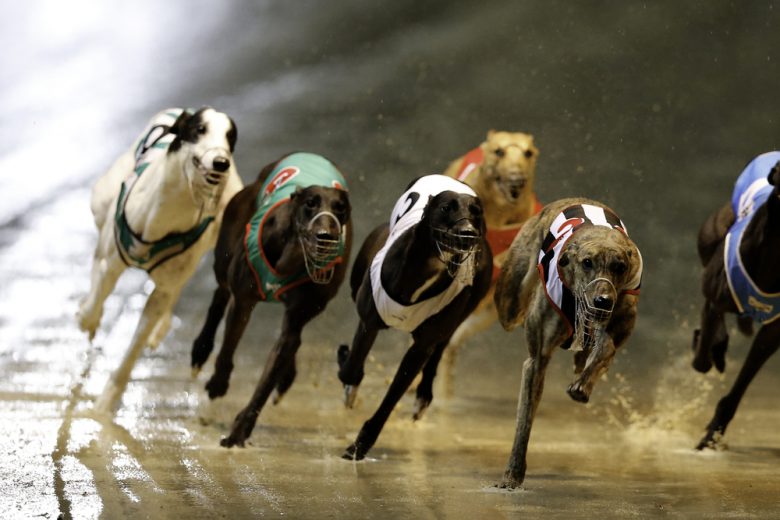
The Time To End Greyhound Racing In Australia Is Now, As Dogs Literally Run For Their Lives
Yesterday was a landmark day for animal activists in Australia as the New South Wales government announced the state-wide end of the greyhound racing industry. This was followed quickly by the ACT state government alluding to a similar ban.
Now, the RSPCA and animal welfare organisations are calling for a national ban of the sport.
This follows the exposure of the damaging levels of “wastage” as an inescapable part of the industry, as dogs are killed because they simply weren’t fast enough, along with the rampant levels of live-baiting – first exposed in an episode of Four Corners last year – and the socially secluded and cruel ways the dogs are kenneled.
The RSPCA has found that up to 13,000 to 17,000 greyhounds will never race and are euthanised every year.
In terms of eradicating live-baiting, RSPCA Australia Chief Scientist Dr Bidda Jones said welfare officers have long had issues catching violators and until recently there have been very few prosecutions of live baiting over the past ten years.
There are examples of inspectors going out to properties and seeing animals that may have been used for live baiting, but they’re unable to do anything.
Instead of focusing solely on live-baiting, the RSPCA’s other concern is how the dogs are treated off the track. Racing is actually a very small portion of their time. The conditions in which they are bred, reared and kennelled, for trainers with several dogs – some have over 20 dogs – the life of a greyhound is in a single pen, on a sleeping platform with a bowl of water.
Full statement from the ACT government. Greyhound racing will be banned in Canberra. pic.twitter.com/ugLpTbgjUG
— Henry Belot (@Henry_Belot) July 7, 2016
Animals Australia have been the loudest voice in calling for an end to the sport, and the conditions the dogs live in is one their main concerns. Each state is different and there is a code of practice that provides the standards on how dogs can live.
Just one example, is that greyhounds only have to be let out of their cages twice a day for 10 minutes each time, which shows the level of confinement and deprivation that some dogs live in.
This is sadly what happens when we put money and profit ahead of the welfare of animals.
HISTORIC: Australia's NSW and ACT Governments announced historic decisions to BAN #GreyhoundRacing ❤???? pic.twitter.com/m36GwLP3uo
— Animals Australia (@AnimalsAus) July 7, 2016
Animal Liberation Queensland (ALQ) was one of the leading organisations involved with uncovering the Four Corners live-baiting footage.
Their major problem is the difficulty regulating the industry, the mass-breeding and mass-killing of dogs every year, and that the dogs are getting injured while they’re racing. The organisation has long-supported a ban on the entire industry.
Since Baird’s announcement, some have said that the closure of the sport won’t only lead to thousands of jobs lost, but the death of dogs, with too many to rehome.
While greyhounds rescue groups, shelter groups and shelter organisations will do all they can do to find homes for as many dogs as they can, the sad reality is that many dogs will be killed.
Life after greyhound racing.
My @smhletters toon. pic.twitter.com/81WpZOQzsm— The Cathy Wilcox (@cathywilcox1) July 7, 2016
But it is the industry that is making these dogs impossible to rehome. The majority haven’t been properly socialised – so arguments that by ending greyhound racing will lead to dogs dying is nonsense; the sport did this to itself.
In time, if the sport ends, causing overbreeding to cease, we will see less greyhounds in shelters and more greyhounds growing up in a loving environment.
Let’s not kid ourselves into thinking greyhound racing in Australia is the booming industry it once was, according to IBISWorld’s Horse and Dog Racing market research report from October 2014, industry revenue has been declining due to stagnant racing attendances and the rising popularity of alternative forms of gambling.
Ending the sport in Australia, will follow the lead of 39 states in the US in banning dog racing and we will join the majority of countries that don’t allow the sport on ethical grounds.
U.S organization GREY2K USA are working towards ending dog racing worldwide, and in the last year has been focusing their efforts towards Australia. President and co-founder of GREY2K USA Christine Dorchak said that since the organisations formation, twenty-eight dog tracks have closed for live racing all across the country and the number of states with dog racing has been cut by more than half.
as a taxpayer I strongly object 2 my hard earned $$s being wasted on such a sick industry that I'm 100% opposed 2!! https://t.co/Rkn0Moe0Q8
— rhonda (@tikibgood) July 7, 2016
GREY2K USA helped set in place the live baiting investigation in Australia with Animals Australia and ALQ, as Dorchak said, Australia must follow their lead:
“Change is hard. In the past, greyhound racing seemed like a fun pastime. It has only been in the last several decades, thanks to increased education, that people have come to realize that dog racing is a losing proposition for the greyhounds involved,” said Dorchak.
“Dog racing will end very soon, due to the public’s increasing awareness about the injuries and deaths of racing greyhounds and the tax breaks and subsidies afforded this cruel industry.”
To illustrate the sad reality of overbreeding, the University of Melbourne has confirmed that they had previously used unwanted greyhounds in its dog blood bank and greyhound cadavers for teaching anatomy to veterinary students.
#GreyhoundRacing must end Australia-wide — or dogs & pups will continue to die for sake of gambling $$. #ShutitDown pic.twitter.com/GaspdZZIev
— Animals Australia (@AnimalsAus) July 7, 2016
In some cases, greyhounds will be put under anesthetic, bled for blood for donor transfusions and then euthanised.
This comes along with the thousands of dogs killed in shelters, unable to be adopted by families.
Greyhounds have literally become the human equivalent of an untouchable, they are abused, used and exploited, becoming an undesirable dog breed to adopt because of the industry they were forced into. This needs to stop and the industry needs to end.
Dogs are supposed to be man’s best friend, not man’s punching bag.
For information on adopting a greyhound, visit Animals Australia.
